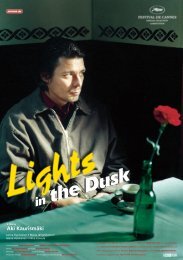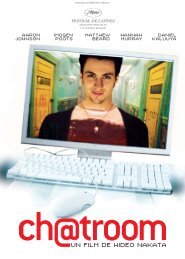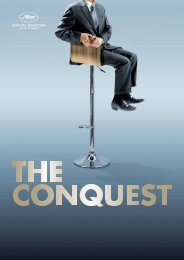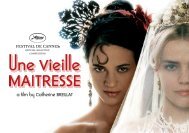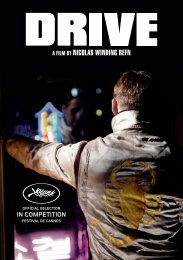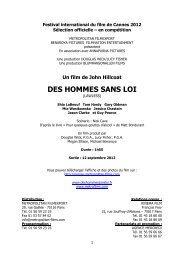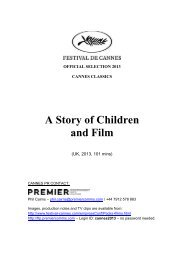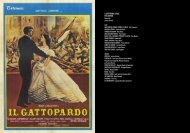English - Cannes International Film Festival
English - Cannes International Film Festival
English - Cannes International Film Festival
Create successful ePaper yourself
Turn your PDF publications into a flip-book with our unique Google optimized e-Paper software.
my encounter<br />
with abbas by Marin Karmitz<br />
8<br />
The first time I came across Abbas Kiarostami was when I was presented with one of his films Close-Up<br />
in the early nineties. It was shown to me by one of his interpreters and I was captivated by both the film’s<br />
subject matter and craftsmanship. I asked to meet the director.<br />
The story of Close-Up is that of a guy pretending to be an important director called Mohsen Makhmalbaf.<br />
I had never heard of him so I asked “Who is Makhmalbaf?” – The interpreter replied that he was<br />
a famous Iranian director. I had asked to meet Abbas Kiarostami, but I met Mohsen Makhmalbaf<br />
instead, and I began producing his films as well as his daughter Samira’s (The Apple) before eventually<br />
hooking up with Kiarostami. Close-Up introduced me to Iranian cinema, which in turn introduced me to<br />
Mohsen Makhmalbaf, who then introduced me to Abbas Kiarostami.<br />
On seeing Close-Up, I fell in love with this artist, like I had with Samuel Beckett, Alain Resnais,<br />
Krzysztof Kieslowski and Claude Chabrol, even though I knew absolutely nothing about him. I immediately<br />
offered to produce one of his films, to which he replied that he didn’t need a producer because he<br />
produced his own films. But then he started telling me stories. I realised that Abbas Kiarostami was not only<br />
a filmmaker but also a talented Persian storyteller. Whilst he told me stories I thought “Ah, what a beautiful<br />
film that would make!” and then another story “Ah, what another beautiful film that would be!”. I noticed<br />
that he was studying me carefully. Every time he came to Paris he would tell me another story. And each<br />
time I would ask him “When are we going to make a film together?” And he would reply “I don’t need a<br />
producer”. I looked upon his stories as gifts, and, in return, I told him stories about cinema.<br />
I stood back as his films such as Life, and Nothing More (1991), Through The Olive Trees (1994),<br />
and others passed me by. Then, when Taste of Cherry won the Palme d’Or in 1997 Abbas Kiarostami<br />
was courted by several producers. On his return to Paris he came to see me and said “That’s it. I’m ready<br />
now for you to produce one of my films”.<br />
By this stage I had almost given up, so I was overjoyed when he came to me. I asked him which one<br />
he would like me to work on. He dived into his treasure trove of stories, and studied my reaction to<br />
each film idea he suggested (something he still does to this day). He moved from story to story until he<br />
found the one that made me really sit up and take notice. The first film we ever made together was<br />
The Wind Will Carry Us.<br />
When you make a film with someone your relationship changes. It was during the making of his film Ten<br />
that I understood his method of working. When he began telling me about his idea for Ten, it was the<br />
story of a psychoanalyst whose husband informs on her to the police. The police come and close down<br />
her practice. She arrives to discover that they have taped off the entrance and she has a queue of<br />
patients waiting outside. So she decides to carry on treating her patients in her car whilst driving around<br />
the city. The final result is not so far off the original telling of the story, but it has been refined, whittled<br />
down to what is essential. I observed how Abbas Kiarostami does this. And what I didn’t realise before<br />
was that he has a very interesting technique: his stories evolve in a similar way to the work of certain<br />
painters or writers: by trimming away and taking out the superfluous he gets to the heart of the story,<br />
the universal truth. This is such a critical skill, yet so rare. Abbas Kiarostami lets his ideas blossom like flowers,<br />
and whereas some wither away, others flourish.<br />
It was around 2002, after the making of Ten that he first mentioned the idea of basing a film in Japan.<br />
As there was no script, I suggested that I film him whilst he explained the story to me. It was about taxi<br />
drivers during one night in Tokyo. I recently looked at that film I made, now 8 years later, and after<br />
Like Someone In Love was finished. In it, I asked Kiarostami to show me the preparatory images that he<br />
had shot, and together we watched them on television with him commenting on the images. We see the<br />
idea for the scene where the taxi that drives round a square, around an old lady. All the elements of<br />
Like Someone In Love are already there, but in note form. It took him 10 years to turn this story into a<br />
finished piece of work.<br />
Abbas Kiarostami has always made draft versions before starting actual filming on the films of his that<br />
I have produced. For Certified Copy there were two whole shoots. Firstly the film was shot with just the<br />
location sets, then with stand-ins before real filming could begin with the actors. These draft versions can<br />
be compared to an artist’s sketches, which he then refers back to, to help him achieve the final result:<br />
the painting. It also reminds me of the sculptor Giacometti, who would leave his work on the studio bench<br />
and either go back to them, leave them, finish them or throw them away. It is a method that I have never<br />
seen used by any other filmmaker. I have never seen such obvious parallels between film-making and<br />
other artistic genres. In cinema we work on scripts, of course we add in the finishing touches but we start<br />
filming relatively quickly. Sometimes maybe, an idea or a subject might take longer to develop but we do<br />
not work with a series of sketches, at least not like Kiarostami.<br />
This working method reinforces my belief that cinema can be compared to a house being built. I expect<br />
the director to provide the bricks to build the house. Not to finish it, but to continue building it so that<br />
others can continue building it too. This is the core of what I expect from film-makers. Some of them are<br />
incapable of providing one brick, even undoing the ongoing work. Some may just bring a pebble, but at<br />
least it’s something and it proves that they want to contribute to the building of the house. But you can’t<br />
build a house alone. You can’t just rely on the walls being built by others. If we don’t have this collaborative<br />
vision of cinema or other forms of artistic expression, then it is a sign of arrogance and self-importance.<br />
Abbas Kiarostami’s working method is akin to building a personal project whilst at the same time contributing<br />
to the construction of a cinematic oeuvre.<br />
9




